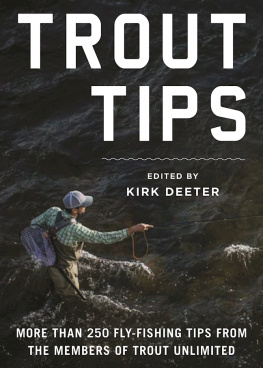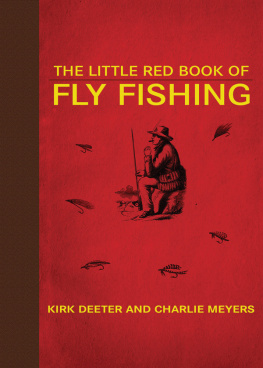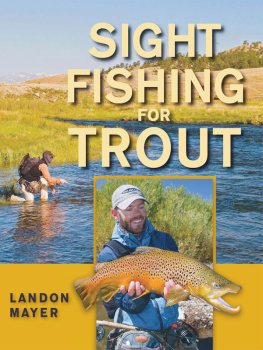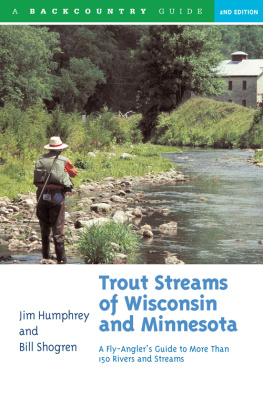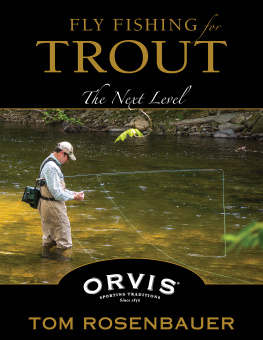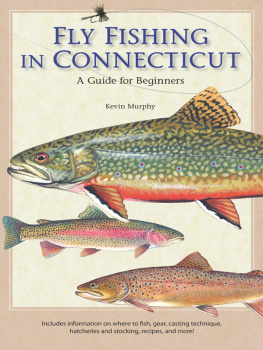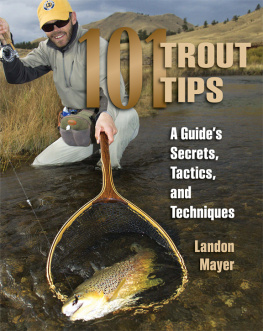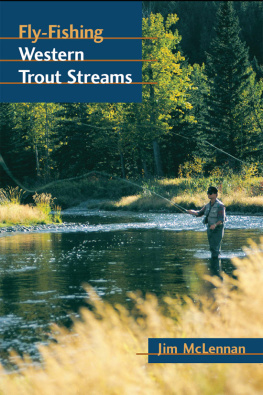Copyright 2017 by Trout Unlimited
All rights reserved. No part of this book may be reproduced in any manner without the express written consent of the publisher, except in the case of brief excerpts in critical reviews or articles. All inquiries should be addressed to Skyhorse Publishing, 307 West 36th Street, 11th Floor, New York, NY 10018.
Skyhorse Publishing books may be purchased in bulk at special discounts for sales promotion, corporate gifts, fund-raising, or educational purposes. Special editions can also be created to specifications. For details, contact the Special Sales Department, Skyhorse Publishing, 307 West 36th Street, 11th Floor, New York, NY 10018 or .
Skyhorse and Skyhorse Publishing are registered trademarks of Skyhorse Publishing, Inc., a Delaware corporation.
Visit our website at www.skyhorsepublishing.com.
10 9 8 7 6 5 4 3 2 1
Library of Congress Cataloging-in-Publication Data is available on file.
Cover design by Tom Lau
Cover photo credit: Tim Romano, courtesy of Scientific Anglers
Interior illustrations courtesy of Rod Walinchus
Print ISBN: 978-1-5107-1370-3
Ebook ISBN: 978-1-5107-1371-0
Printed in China
THIS BOOK IS DEDICATED TO THE MANY CURRENT AND PAST MEMBERS OF TROUT UNLIMITED WHO HAVE DONE, AND CONTINUE TO DO, THE EXTRAORDINARY WORK THAT MAKES TROUT FISHING POSSIBLE IN THE FIRST PLACE.THANK YOU.
Take care of the fish, and the fishing will take care of itself.
Art Neumann, co-founder of Trout Unlimited

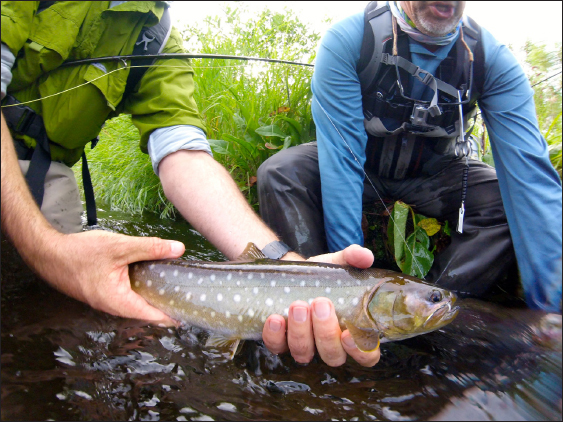
Contents
Acknowledgments
T his book is a true group effort, and the culmination of many river miles, waded and fished by many friends, colleagues, and kindred spirits. Thanks to all the TU staffers and volunteers around the country who pulled together to make this book possible. Special thanks to Chris Wood, president and CEO of TU, for having faith in the project to begin with, and to the Trout Media staff, especially Samantha Carmichael, Erin Block, and Jim Gray, for their support. I also want to thank my friends at Field & Stream magazine for their flexibility and the opportunity to write for the leading outdoors media brand in the world. Thank you to my business partner and good friend Tim Romano, Mr. Reliable. Thanks to my editor and friend Jay Cassell, who has been my editor and friend for many years before we tackled this project (and were still pals!). Last, but not least, thanks to my very supportive family, especially my wife, Sarah, and son, Paul, with whom I enjoy chasing trout in wild places most of all.
Foreword
M y high school basketball coach from Jersey City once told me, you may think youre a pretty good ball player, but I can go to any street corner in this city, and find someone who can beat you in one on one. It is the fact that you are part of a team that makes us all better. The same could be said for fly-fishing. Most of us know how to get the line on the water. We know, generally, where to find fish. We are all fairly proficient at putting the bugs the TU business fly-shop sold us where they need to go. But much like a basketball team, we become better anglers when we take the time to learn from others who share our passion.
Trout Unlimited has more than 220 staff and 400 chapters spread all across the country who work in common cause toward a specific goal: to make your fishing better. That is what makes it so heartwarming to see these tips from all over the countrymen, women, kids, novice anglers, old-handsthats the Trout Unlimited family at work, and everyone plays a part. The book is a reflection of Trout Unlimiteds belief that many hands make heavy lifting easy.
But the bottom line is that you can cast 100 feet, tie the deadliest pattern in the world, and make it swim prettier than Michael Phelps, but none of that matters if there are not fish in the water. So, if you are already a supporter of Trout Unlimited, thank you. If not, and you love to fish, and want to surround yourself with others who will make you a better angler and help you to give back to this resource we all love, join Trout Unlimited today.
Chris Wood,
CEO of Trout Unlimited
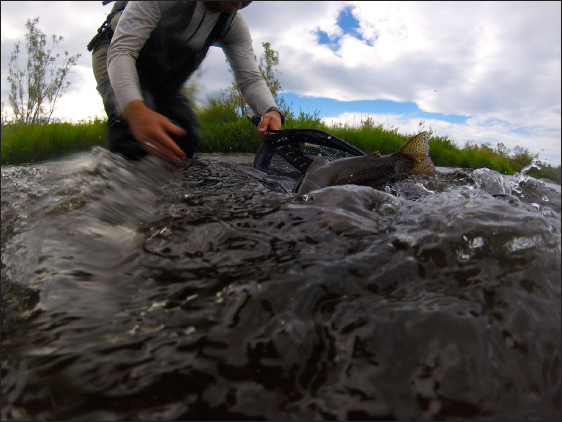
Introduction
I have always felt that fly fishing for trout is ultimately less about flies and trout, and more about the people you meet, and the places you experience along the way.
Thats not to say that I dont appreciate the unique tranquility that can only be found on a river with a fly line whispering a four-count rhythm overhead, and cool water pressing around my legs. And I like the tug a trout makes, particularly after theyve risen for a dry fly. A lot.
But it seems to me that, while I might snap some fish photos along the way, at the end of the day or at the end of the trip, I dont remember the fish as much as I remember the place and the person (or people) I was fishing with. Even fishing in total solitude, I remember the person I was thinking aboutthe one who taught me this trick or inspired me to find that place. One of the most beautiful aspects of fly fishing for trout is that you are never truly alone. You are always part of something larger than yourself. Nature tradition community.
Having had the good fortune to fish many rivers throughout North America and beyond, I have grown particularly fascinated with lifting tips from one watershed and trying to apply them to another. Will this killer fly pattern from the Madison work on the Delaware, as well? Will I find a trout holding in that subtle seam on the Pere Marquette, just like I did on the Deschutes? I wonder if I can skate this bug on Silver Creek like I did on the Upper Colorado
As with all things fly fishing, the answer to these questions is usually a definite maybe.
Several years ago, I wrote a book with my outdoor writing mentor, the late, great Charlie Meyers, former outdoors columnist for the Denver Post . Its called The Little Red Book of Fly Fishing . And it has done very well, because it was all about definite maybes. Charlie had rolled and fished enough rivers in his day to know that nothing is an absolute. (He thought, for example, that anyone who professed to be an all-knowing guru on any aspect of fly fishing was, in truth, an absolute nut. And I agreed with him.) The smartest anglers realize that the more they fish, the more they can still learn.
Sure, there are some fundamentals to share (like scales and chords for the musician), but good fishing is always about improvisation, and playing to the beat you hear in your head. As reporters, Charlie and I merely shared tips and tricks we picked up in our collective travels. Usually, we agreed. Sometimes we contradicted each other on purpose. It was important to let the reader sort it out for himself or herself.
After all, fly fishing for trout is problem solving. How do I get this fly into the mouth of that fish swimming 40 feet away from me? If there were a step-by-step instruction manual that explained how to solve that problem, every time, nobody would want to read it, and nobody would want to fish.

